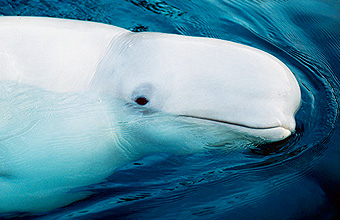
Beluga (Qilalugaq)
Belugas live primarily in areas of the Arctic with sea ice. There are about 150,000 beluga whales, two-thirds of which summer in Canadian waters. Belugas migrate to specific main feeding, moulting and nursery areas every year, feeding on a variety of fish and invertebrate species. Despite being one of the most resilient whale species in the Arctic, they have been impacted by rapid climate change, chemical and noise pollution and historical over-exploitation.
###Importance Beluga whales are close to the top of the marine food chain and are powerful indicators of the overall health of the marine environment. They are also culturally important to many Inuit communities in the Arctic, as a traditional source of food.
###Potential impact of an oil spill Evidence from other small to medium sized whale species suggests high vulnerability to oiling from spills, both from direct oiling of skin at their blow holes and eyes, and from ingestion while breathing at the surface. Oil contamination within the food chain (of zooplankton and fish species) also represents a major potential risk, especially when key feeding areas become oiled.
Sources
- Distribution of endemic cetaceans in relation to hydrocarbon development and commercial shipping in a warming Arctic. Marine Policy. Reeves et al. 2014
- WWF-Canada
- MAP DATA: Audubon - Alaska
Adapted from: Selected records from Fisheries and Oceans Canada (Oceans Program), Marine Species Distribution and Marine Protected Areas Database.
This product has been produced by the Fisheries and Oceans Canada (Oceans Program) for use in marine planning initiatives. Reproduced with permission of Fisheries and Oceans Canada (Oceans Program).